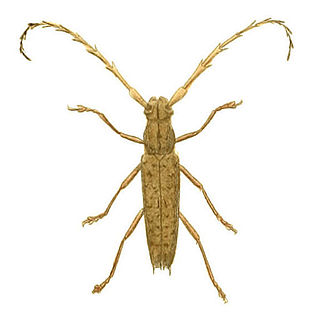
Are is a monotypic moth genus in the subfamily Arctiinae erected by Francis Walker in 1855. The type species is Are druryi, which is found on Jamaica. This species was described by Dru Drury in 1773 under the name Phalaena marginata, but this name is preoccupied by Phalaena marginataLinnaeus, 1758 and a new specific epithet, honouring Drury, was assigned in 1986.

Orthomegas cinnamomeus is a species of beetle in the genus Orthomegas of the family Cerambycidae. It was described by Carl Linnaeus in his landmark 1758 10th edition of Systema Naturae. It is found in Hispaniola, Trinidad, Colombia, Venezuela, the Guianas, Brazil, Ecuador, Peru and Bolivia.

Archodontes is a genus of root-boring beetles in the family Cerambycidae. It is monotypic, being represented by the single species Archodontes melanopus. It is endemic to Central America and the south-eastern United States, and bores the roots of oaks and other hardwoods.

Trachyderes succinctus is a species of beetle in the family Cerambycidae. It was described by Carl Linnaeus in his landmark 1758 10th edition of Systema Naturae.

Trichura coarctata is a moth in the subfamily Arctiinae. It was described by Dru Drury in 1773. It is found in Brazil.

Neoclytus longipes is a species of beetle in the family Cerambycidae. It was described by Dru Drury in 1773.
Eburia quadrimaculata is a species of beetle in the family Cerambycidae.

Elaphidion irroratum is a species of beetle in the family Cerambycidae. It was described by Carl Linnaeus in his 1767 12th edition of Systema Naturae.

Elaphidion spinicorne is a species of beetle in the family Cerambycidae. It was described by Dru Drury in 1773 from Jamaica.

Enaphalodes atomarius, also known as the robust oak borer, is a species of beetle in the family Cerambycidae. It was described by Dru Drury in 1773 from New York City.

Steirastoma pustulata is a species of beetle in the family Cerambycidae. It was described by Dru Drury in 1773 from Jamaica.

Galerita americana is a species of beetles in the family Carabidae. It is native to Central and South America.

Imbrasia epimethea is a species of moth belonging to the family Saturniidae. It was first described by Dru Drury in 1773 from the Calabar coast.

Electrostrymon pan is a butterfly of the family Lycaenidae. It was described by Dru Drury in 1773 from Jamaica.

Letis hercyna is a species of moth in the family Erebidae. It was first described by Dru Drury in 1773 from Jamaica.

Sternotomis mirabilis is a genus of long-horned beetle belonging to the family Cerambycidae. It was first described in 1773 by Dru Drury from Sierra Leone.

Prosopocera bipunctata is a species of flat-faced longhorn beetles in the subfamily Lamiinae. It was first described by Dru Drury in 1773, from Sierra Leone.

Gaeana maculata is the type species of cicadas in the genus Gaeana. It was first described by Dru Drury in 1773, from China.

Lobobunaea phaedusa is a species of very large moths in the family Saturniidae. It is found in much of sub-saharan Africa, where its host plants include African custard-apple, crown-berry, and Aframomum spp.

Thysania zenobia, the owl moth, is a species of moth in the family Erebidae. The species was first described by Pieter Cramer in 1776, and is native to North and South America and the Caribbean.




















